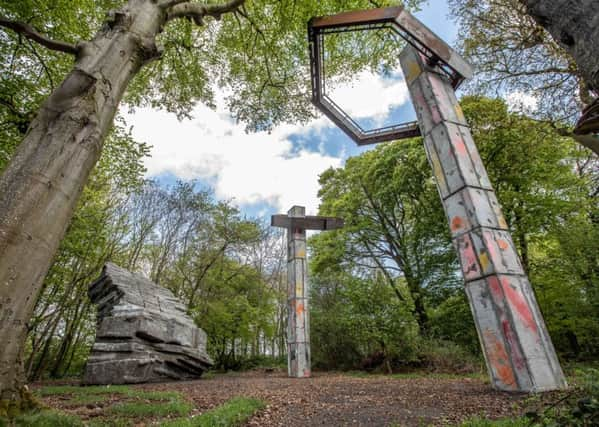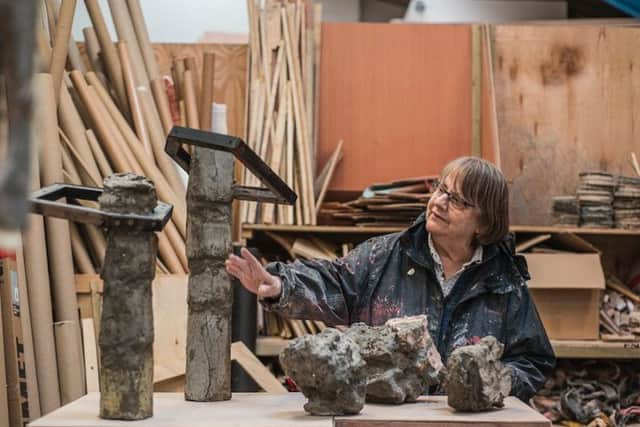Art interview: Phyllida Barlow on her new commission for Jupiter Artland near Edinburgh


Already, Phyllida Barlow’s new sculpture is being subsumed by nature. When Quarry was installed at Jupiter Artland six weeks ago, the towering columns stood out among bare trees, but now they are bathed in an embrace of greenery.
Quarry, unveiled earlier this month when the sculpture park just outside Edinburgh reopened for the summer, is one of Barlow’s first permanent outdoor commissions. Having spent most of her life recycling her sculptures into new work, she is intrigued by the idea of something lasting. “I think the permanence thing is really interesting,” she says. “And having the good fortune to put the permanence in amongst nature, which is constantly changing, hour by hour. It’s wonderful to know that the work has got to tolerate that. You can’t be precious about that.”
Advertisement
Hide AdPrecious is one thing Barlow is not. Suddenly finding herself in the art world’s A-list in her mid sixties has left her thoughtful, philosophical. She speaks insightfully about her work, always with curiosity, as if she is still working out what it means. Sitting in the elegant drawing room of Bonnington House, the home of Robert and Nicky Wilson, owners of the Jupiter Artland estate, we survey the coffee table, groaning under its collection of expensive-looking art books, and wonder where to put our mugs of tea. “I’ve put mine on William Kent,” says Barlow, cheerfully.


She is here with her family (a sister, who is Barlow’s spitting image, comes up to introduce herself) to celebrate the unveiling of the new work, and speaks with a barely disguised sense of wonder at the opportunities she finds herself being offered. Making the outdoor commission was “completely liberating, no walls, no floor, no official entry point”. But it was a challenge, too. “It took me some time to get into what it was that I could relate to. Nature is so… powerful, and it has to be given priority. I don’t want to stamp all over it, but on the other hand I didn’t want to be intimidated by it.”
She started to imagine man-made structures, like abandoned industrial plant, being subsumed by nature: “Their use is no longer there so there’s almost a sense of the monument that doesn’t know what it’s being monumental for. It began to seem a possibility. And the height of the trees and their monumentality – could I reciprocate that in a way which was very empathetic, but also wasn’t intimidated?”
The work then “emerged”: two concrete columns, one ten metres high, the other 12 metres. At the top, each carries a great steel frame, roughly hexagonal, framing the canopy of branches and the sky. “I kept thinking about what I had done in the woods when I first went through them, which was constantly to look up. That was a key to what I wanted to bring to these woods, hopefully to enable an audience to look up in the way that I had.”
Barlow is now 74, and regarded as one of Britain’s most important sculptors. Having spent her life teaching at the Slade (where her students included Martin Creed, Rachel Whiteread, Tacita Dean and Douglas Gordon), raising her family, and making and showing work when she could, she found herself, in 2010, welcomed into the stable of prestigious London gallery Hauser & Wirth. World-class opportunities followed, with Barlow rising graciously to each one, from a commission for the Tate’s 320-foot long Duveen Galleries, to last year’s challenge: representing the UK at the Venice Biennale.
There is something about her work which resonates with the contemporary moment: her preference for lo-fi materials – hardboard, cement, polystyrene – and the ambition to build these into monumental structures, yet structures which teeter and sprawl, embracing mess, absurdity, provisionality. John Walter, whose touring exhibition Shonky: The Aesthetics of Awkwardness is currently at DCA in Dundee, has crowned her the “high priestess of shonky”.
Advertisement
Hide AdBut creating a permanent structure of the scale of Quarry has brought new challenges. Barlow’s preferred method of working – putting up, taking down, improvising, replacing – doesn’t work here. Columns 12 metres high require the opposite: planning, structural engineering, specialist fabricators. “It was heavy-going and very slow, and I’m impatient,” she says. “Now, I think there could be tweaking, but you can’t tweak things that are 10 metres and 12 metres high.”
She is concerned about how to maintain the sense of hands-on making while working on a monumental scale: even her indoor installations, like the work for the Fruitmarket Gallery in Edinburgh in 2015, are built by an army of assistants under her direction. She shudders at the idea of sending plans to fabricators and waiting to see what emerges. “My husband (the artist Fabian Peake) is a painter. He does absolutely everything himself, and I’m deeply envious of that. But if I’m going to have these ambitions, I have to find a middle ground where I can delegate and also be involved at the same time.”
Advertisement
Hide AdThe two columns are accompanied by a third work, a tottering stone staircase which looks like a fragment of a much older ruin; one suspects, the more overgrown it becomes, the more authentic it will appear. But it’s not old, and this interests Barlow too. “In that sense it’s a kind of fake, which is something I’m quite intrigued by in sculpture: marble pretending to be flesh, or bronze being able to take on the form of a human body. Sculpture is quite a deceitful art form.”
She has been interested by ruins for a long time, but now she’s wondering if it’s time to move on: “I want to ask myself, what is it about being alive now? The idea that the thing is not from the past, but is a kind of phantom of an object, an emotional response to a world in turmoil.”
Barlow found herself in the unenviable position of making work for the British Pavillion in Venice at the time of the Brexit referendum in 2016. “The [British] pavillion is a very formal building and sits in a very dominant place [in the Giardini], so there was something quite vulnerable about that, with the country going through turmoil. I couldn’t ignore it. But is that the subject of the work? That’s the question.”
The answer to that is no, but also, possibly, yes. The Venice work was titled Folly; columns and rough-hewn forms seemed to burst out of the neo-classical pavillion, sinister yet at the same time faintly ridiculous. It referenced architectural follies, of course, but also “the folly of how politics unravel”.
“The way the works come about is often extremely expedient, but to me they are dealing very much with being alive now. There’s an issue of: is the space controlling the work or the work controlling the space? The way the sculpture takes on different contexts is a metaphorical or symbolic way of relating to systems of authority. Where are the controls in our society?”
Phyllida Barlow: Quarry is at Jupiter Artland, near Edinburgh, www.jupiterartland.org